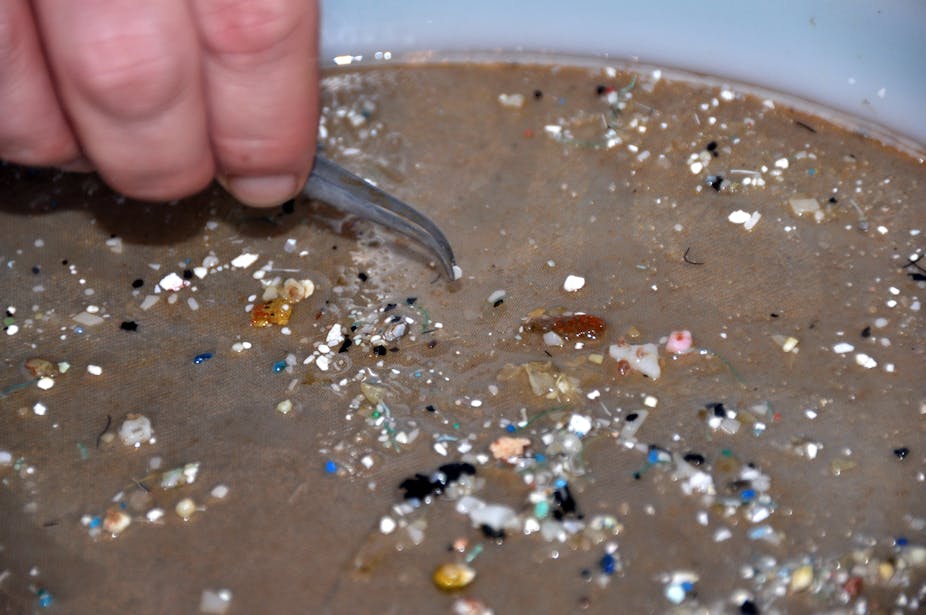The amount of plastic debris accumulating in the open ocean has doubled in 40 years. This has been is a topic of increasing public concern and scientific interest since it was first reported in the 1970s.
It conjures up images of islands of garbage, the proverbial “Great Pacific Garbage Patch” twice the size of France, but for those who have sailed through it, the reality is much less sensational. Despite popular conception, large pieces or visible accumulations are rare. Instead, nets towed at the sea surface typically catch confetti-sized plastic pieces called microplastics.
These small pieces are post-consumer waste (stuff you and I have thrown out), and the majority appears to be floating polyethylene and polypropylene, unlike for example the plastic used for bottled water (polyethylene terephthalate, or PET) that sinks to the ocean floor.
A large fraction of this plastic is produced for single use packaging and eludes recycling efforts. A piece of low density plastic dropped into coastal waters on the east coast of the United States can be carried by surface currents to the centre of the North Atlantic Subtropical Gyre, also known as the Sargasso Sea in about six weeks. Here the plastic is trapped by currents, with little chance of escape. Sadly plastic debris has been found in all five major ocean gyres, and in the Southern Ocean, in what is usually considered “pristine” open water.
In 2010 Science Magazine published the surprising finding that the overall amount of plastic in the North Atlantic Ocean is remarkably stable. Where is all the plastic going? Other research has revealed that it is broken down by ultraviolet light and physical abrasion. As biologists we took a closer look at what lives on plastic marine debris in the ocean to see what role sea organisms might play in the fate of plastic marine debris.
Our study recently published in Environmental Science and Technology provides compelling evidence that part of the answer rests with the ocean’s “hidden majority” – the smallest oceanic lifeforms comprised of marine microbes: bacteria and other single-cell organisms. Ours is the first description of microbial life associated with plastic marine debris from the open ocean.
Using a combination of high-powered microscopy and state-of-the-art DNA sequencing, we found a diverse array of microscopic organisms living on plastic marine debris, and they are distinct from the “natural” community in the surrounding waters or on floating seaweeds. We are describing the “natural history” of an unnatural substrate. There are thousands of different micro-organisms on a piece of plastic half the size of a fingernail, some of which appear to live specifically on the plastic.
We refer to this community as the “Plastisphere”. Like the biosphere (the thin film of life around the surface of planet Earth), the Plastisphere represents a little world of life that exists on the surface of plastic particles. This environment comes complete with predators and prey, organisms that photosynthesise to produce energy from light, (similar to plants on land), and even parasites and potentially disease-causing organisms harmful to invertebrates, fish and humans.

Perhaps our most compelling observation was the discovery of what we call “pit-formers”: conspicuous cells that appeared to be embedded in pits on the plastic surface – somewhat likes eggs in an egg carton. We hypothesise that these curious residents play some part in breaking down the plastics. That’s not to say that the pit-formers are necessarily biodegrading plastic down to its constituent water and carbon. This claim would require further laboratory testing. However, any breakdown of plastics into progressively smaller bits is noteworthy because it might explain why the amount of plastic doesn’t seem to be increasing over the long term.
This process also has potentially serious consequences. It is sobering to realise that the estimated global annual plastic production of 245m tonnes represents 35kg of plastic per person per year for each of the seven billion people on the planet. This is, approximately, the total combined weight of the entire human race.
A considerable amount will end up in the ocean, where it will gradually degrade into smaller pieces. At the base of marine food webs is plankton, including zooplankton, small creatures that generally filter tiny food particles from the water. As plastic fragments shrink in size, the chance of plankton eating them increases. If plastic and toxic chemicals associated with some plastics enter the food chain at the bottom, they may pass up through the food chain and ultimately could accumulate in the fish we eat for dinner - and that’s something worth researching.

